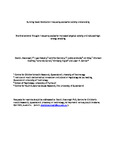The Motivational Thought Frequency scales for increased physical activity and reduced high-energy snacking
| dc.contributor.author | Kavanagh, DJ | |
| dc.contributor.author | Teixeira, H | |
| dc.contributor.author | Connolly, J | |
| dc.contributor.author | Andrade, Jackie | |
| dc.contributor.author | May, Jon | |
| dc.contributor.author | Godfrey, S | |
| dc.contributor.author | Carroll, A | |
| dc.contributor.author | Taylor, K | |
| dc.contributor.author | Connor, JP | |
| dc.date.accessioned | 2020-04-29T10:01:22Z | |
| dc.date.issued | 2020-05-16 | |
| dc.identifier.issn | 1359-107X | |
| dc.identifier.issn | 2044-8287 | |
| dc.identifier.uri | http://hdl.handle.net/10026.1/15610 | |
| dc.description.abstract |
<jats:sec><jats:title>Objectives</jats:title><jats:p>The Motivational Thought Frequency (MTF) Scale has previously demonstrated a coherent four‐factor internal structure (<jats:italic>Intensity, Incentives Imagery, Self‐Efficacy Imagery, Availability</jats:italic>) in control of alcohol and effective self‐management of diabetes. The current research tested the factorial structure and concurrent associations of versions of the MTF for increasing physical activity (<jats:italic>MTF‐PA</jats:italic>) and reducing high‐energy snacks (<jats:italic>MTF‐S</jats:italic>).</jats:p></jats:sec><jats:sec><jats:title>Design</jats:title><jats:p>Study 1 examined the internal structure of the MTF‐PA and its concurrent relationship with retrospective reports of vigorous physical activity. Study 2 attempted to replicate these results, also testing the internal structure of the MTF‐S and examining whether higher MTF‐S scores were found in participants scoring more highly on a screening test for eating disorder.</jats:p></jats:sec><jats:sec><jats:title>Methods</jats:title><jats:p>In Study 1, 626 participants completed the MTF‐PA online and reported minutes of activity in the previous week. In Study 2, 313 participants undertook an online survey that also included the MTF‐S and the Eating Attitudes Test (EAT‐26).</jats:p></jats:sec><jats:sec><jats:title>Results</jats:title><jats:p>The studies replicated acceptable fit for the four‐factor structure on the MTF‐PA and MTF‐S. Significant associations of the MTF‐PA with recent vigorous activity and of the MTF‐S with EAT‐26 scores were seen, although associations were stronger in Study 1.</jats:p></jats:sec><jats:sec><jats:title>Conclusions</jats:title><jats:p>Strong preliminary support for both the MTF‐PA and MTF‐S was obtained, although more data on their predictive validity are needed. Associations of the MTF‐S with potential eating disorder illustrate that high scores may not always be beneficial to health maintenance.</jats:p></jats:sec> | |
| dc.format.extent | 558-575 | |
| dc.format.medium | Print-Electronic | |
| dc.language | en | |
| dc.language.iso | en | |
| dc.publisher | Wiley | |
| dc.rights | Attribution-NonCommercial 4.0 International | |
| dc.rights | Attribution-NonCommercial 4.0 International | |
| dc.rights | Attribution-NonCommercial 4.0 International | |
| dc.rights | Attribution-NonCommercial 4.0 International | |
| dc.rights | Attribution-NonCommercial 4.0 International | |
| dc.rights | Attribution-NonCommercial 4.0 International | |
| dc.rights | Attribution-NonCommercial 4.0 International | |
| dc.rights | Attribution-NonCommercial 4.0 International | |
| dc.rights.uri | http://creativecommons.org/licenses/by-nc/4.0/ | |
| dc.rights.uri | http://creativecommons.org/licenses/by-nc/4.0/ | |
| dc.rights.uri | http://creativecommons.org/licenses/by-nc/4.0/ | |
| dc.rights.uri | http://creativecommons.org/licenses/by-nc/4.0/ | |
| dc.rights.uri | http://creativecommons.org/licenses/by-nc/4.0/ | |
| dc.rights.uri | http://creativecommons.org/licenses/by-nc/4.0/ | |
| dc.rights.uri | http://creativecommons.org/licenses/by-nc/4.0/ | |
| dc.rights.uri | http://creativecommons.org/licenses/by-nc/4.0/ | |
| dc.subject | motivation | |
| dc.subject | assessment | |
| dc.subject | imagery | |
| dc.subject | physical activity | |
| dc.subject | diet | |
| dc.title | The Motivational Thought Frequency scales for increased physical activity and reduced high-energy snacking | |
| dc.type | journal-article | |
| dc.type | Journal Article | |
| dc.type | Research Support, Non-U.S. Gov't | |
| plymouth.author-url | https://www.webofscience.com/api/gateway?GWVersion=2&SrcApp=PARTNER_APP&SrcAuth=LinksAMR&KeyUT=WOS:000532982700001&DestLinkType=FullRecord&DestApp=ALL_WOS&UsrCustomerID=11bb513d99f797142bcfeffcc58ea008 | |
| plymouth.issue | 3 | |
| plymouth.volume | 25 | |
| plymouth.publication-status | Published | |
| plymouth.journal | British Journal of Health Psychology | |
| dc.identifier.doi | 10.1111/bjhp.12422 | |
| plymouth.organisational-group | /Plymouth | |
| plymouth.organisational-group | /Plymouth/Admin Group - REF | |
| plymouth.organisational-group | /Plymouth/Admin Group - REF/REF Admin Group - FoH | |
| plymouth.organisational-group | /Plymouth/Faculty of Health | |
| plymouth.organisational-group | /Plymouth/Faculty of Health/School of Psychology | |
| plymouth.organisational-group | /Plymouth/REF 2021 Researchers by UoA | |
| plymouth.organisational-group | /Plymouth/REF 2021 Researchers by UoA/UoA04 Psychology, Psychiatry and Neuroscience | |
| plymouth.organisational-group | /Plymouth/REF 2021 Researchers by UoA/UoA04 Psychology, Psychiatry and Neuroscience/UoA04 REF peer reviewers | |
| plymouth.organisational-group | /Plymouth/Research Groups | |
| plymouth.organisational-group | /Plymouth/Research Groups/Centre for Brain, Cognition and Behaviour (CBCB) | |
| plymouth.organisational-group | /Plymouth/Research Groups/Centre for Brain, Cognition and Behaviour (CBCB)/Behaviour | |
| plymouth.organisational-group | /Plymouth/Research Groups/Centre for Brain, Cognition and Behaviour (CBCB)/Cognition | |
| plymouth.organisational-group | /Plymouth/Research Groups/Institute of Health and Community | |
| plymouth.organisational-group | /Plymouth/Research Groups/Plymouth Institute of Health and Care Research (PIHR) | |
| plymouth.organisational-group | /Plymouth/Users by role | |
| plymouth.organisational-group | /Plymouth/Users by role/Academics | |
| dc.publisher.place | England | |
| dcterms.dateAccepted | 2020-04-12 | |
| dc.rights.embargodate | 2021-5-16 | |
| dc.identifier.eissn | 2044-8287 | |
| dc.rights.embargoperiod | Not known | |
| rioxxterms.versionofrecord | 10.1111/bjhp.12422 | |
| rioxxterms.licenseref.uri | http://creativecommons.org/licenses/by-nc/4.0/ | |
| rioxxterms.licenseref.startdate | 2020-05-16 | |
| rioxxterms.type | Journal Article/Review |



